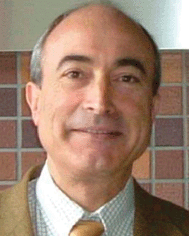Carbon nanostructures—Introducing the latest web themed issue
Nazario
Martín
ab,
Dirk M.
Guldi
c and
Luis
Echegoyen
d
aDepartamento de Química Orgánica, Facultad de Ciencias Químicas, Universidad Complutense de Madrid, Ciudad Universitaria s/n, 28040 Madrid, Spain. E-mail: nazmar@quim.ucm.es
bIMDEA-Nanoscience, Campus de Cantoblanco, 28049 Madrid, Spain
cDepartment of Chemistry and Pharmacy & Interdisciplinary Center for Molecular Materials, Friedrich-Alexander-Universitaet Erlangen-Nuernberg, Egerlandstr. 3, 91058 Erlangen, Germany. E-mail: dirk.guldi@chemie.uni-erlangen.de
dRobert A. Welch Professor, Department of Chemistry, University of Texas - El Paso, 500 W. University Ave., El Paso, Texas 79968, USA
Of all the elements in the periodic table, only carbon provides the basis for life on earth. Carbon is also the key for many technological applications ranging from drugs to synthetic materials that have become indispensable in our daily life and have influenced the world's civilization for centuries. Importantly, the structural diversity of organic compounds and molecules results in sheer endless chemical and physical properties. Altering the periodic binding motifs in networks of sp3-, sp2-, and sp-hybridized C-atoms represents the conceptual starting point for constructing a wide palette of carbon allotropes. To this end, the past two decades have served as a test-bed for measuring the physico-chemical properties of carbon in reduced dimensions starting with the advent of fullerenes (0D), followed in chronological order by carbon nanotubes (1D), carbon nanohorns, and, most recently, by graphene (2D) and poised for wide-ranging applications.
The first successful preparation of 0D fullerenes in macroscopic quantities by the evaporation and recondensation of graphite was reported in 1990. 0D fullerenes are now readily available and exhibit exciting characteristics. For example, the delocalization of charges within the giant, spherical carbon framework together with the rigid, confined structure of the aromatic π-sphere offers unique opportunities for stabilizing charged entities. Above all, the small reorganization energies of fullerenes in charge transfer reactions have led to a notable breakthrough in synthetic electron donor acceptor systems by providing accelerated charge separation and decelerated charge recombination.
Conceptually, 1D single wall carbon nanotubes (SWCNT) are considered as small strips of graphene sheets that have been rolled up to form perfect seamless single walled nanocylinders. The graphene sheets can be wrapped in a variety of ways that are denoted by a pair of indices (n,m), which define both the diameter and the chirality of SWCNTs. SWCNTs, for which the difference between n and m is a multiple of three, are metallic, in contrast to the rest, which are semiconducting. The small diameters and the large aspect ratios of SWCNTs render them ideal one-dimensional quantum wires. The electrical transport in metallic SWCNTs is ballistic, that is, electrons are not subject to any scattering events over a length scale of several micrometers or from any electromigration, even at room temperature. As a consequence, SWCNTs can carry current densities approximately 1000 times that of a typical copper wire. Electron transport is also ballistic for semiconducting SWCNTs, but only over distances of a few hundred nanometers.
Single wall carbon nanohorns (SWNH), conical tubules closed by cone-shaped caps that resemble horns have emerged as a yet largely unexplored carbon allotrope. The cones are formed abstractly by cutting a wedge from graphite sheet and connecting the exposed edges in a seamless manner. SWNHs associate with each other to form “dahlia flowerlike structured assemblies” that have average diameters between 80 and 100 nm. X-ray diffraction showed that the interhorn distance is 0.4 nm, which is slightly larger than the interlayer spacing of 0.335 nm in graphite. Such considerations explain the microporosity and mesoporosity of SWNHs as well as their n-type semiconductivity.
The youngest representative of synthetic carbon allotropes is 2D graphene. Single graphene layers were first prepared successfully in 2004 by simple mechanical exfoliation of graphite using Scotch Tape. Other fabrication strategies, in particular epitaxial growth and solubilization from bulk graphite, have been demonstrated and are paving the way to systematic experiments and technological applications. Transport measurements show that graphene has remarkably high electron mobility at room temperature, with reported values exceeding 15.000 cm2 V−1 s. Additionally, the symmetry of the experimentally measured conductance indicates high mobility for holes and electrons. An ideal monolayer of graphene has an optical transmittance of 97.7%. In summary, graphene should be a cost-effective and abundant source for transparent conductive electrode applications.
The scope of this special web themed issue of Chemical Communications refers to all the classes of carbon nanoforms and the use that mainly chemists have made to construct a huge number of modified structures which enhance their potential use for practical purposes. Furthermore, most of these carbon nanostructures require the chemical functionalization as a previous step to their use as materials for the preparation of devices. In this regard, the imagination of chemists is the only limit for the development of these unique carbon-based and unprecedented materials.
Please note that all articles being published as part of this web themed issue will only be available, as a collection, online at www.rsc.org/chemcomm/carbonnanostructures. The articles will be published individually across a number of print issues, as this depends on issue availability at the time of the article being published online as an advanced article.
Nazario Martín is full professor of Organic Chemistry at the UCM and vice-director of the Institute of Madrid for Advanced Studies in Nanoscience (IMDEA-Nanoscience). Professor Martín's research interests span a range of targets with emphasis on the chemistry of carbon nanostructures such as fullerenes and carbon nanotubes, π-conjugated systems as molecular wires, and electroactive molecules in the context of electron transfer processes, photovoltaic applications and nanoscience.
Dirk M. Guldi is well-known for his contributions to the areas of charge-separation in donor–acceptor materials and construction of nanostructured thin films for solar energy conversion. His scientific career began at the University of Köln, graduating with undergraduate and PhD degrees. After a postdoctoral stay at the National Institute of Standards and Technology in Gaithersburg/USA, he took a position at the Hahn-Meitner-Institute Berlin. Following a brief stay as a Feodor-Lynen Fellow at Syracuse University/USA he joined the faculty of the Notre Dame Radiation Laboratory/USA. Then, after nearly a decade in the USA, the University of Erlangen-Nürnberg finally succeeded in attracting him back to Germany.
Luis Echegoyen obtained his undergraduate and PhD degrees from the University of Puerto Rico in Río Piedras. After various placements he then spent 18 years at the University of Miami, before becoming Professor and Chairman of the Chemistry Department at Clemson University in 2002. In 2006 he became the Director of the Division of Chemistry at the NSF, a position he held until 2010. He is now the Robert A. Welch Professor of Chemistry at the University of Texas – El Paso. He has more than 300 publications in diverse fields ranging from crown ether and fullerene electrochemistry to LB and SAM film formation and characterization.
| This journal is © The Royal Society of Chemistry 2011 |



